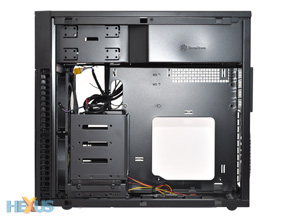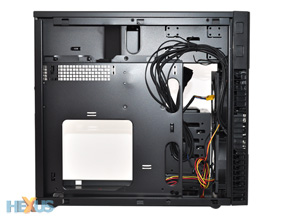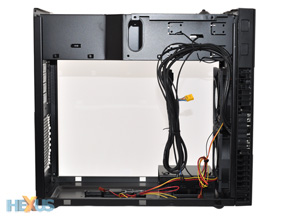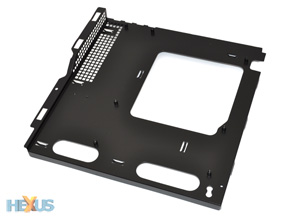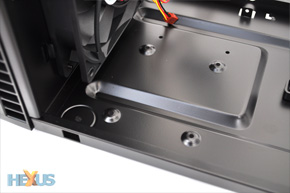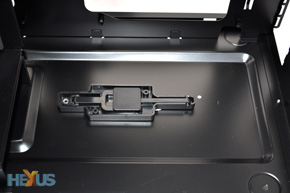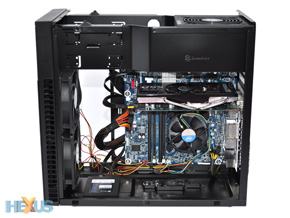Inside the Precision Series PS07
Stating the obvious, the Precision Series PS07 isn't as roomy as a mid-tower alternative. Open her up, and the chassis initially feels a little tight and awkward to work with. Fortunately, SilverStone has planned ahead, and, by integrating various removable compartments, has created a chassis that opens up and becomes really, really simple to build into.
It's so flexible, in fact, that we found it easier to work with than most mid-tower alternatives. Pictured above is the chassis without its side panels (both of which are removed by a pair of thumb screws), but by undoing a couple more screws, you can go from the above to this:
What we have here is the chassis with its top panel, hard-disk cage and motherboard tray all removed to clear the internal confines and aid the build process. Removable motherboard trays, remember those?
Peeling all these layers away makes component installation a breeze. The top-mounted PSU slots in without fuss, CPU cooler installation is a doddle - with a large cutout to help with installation - and cable-management works surprisingly well. There are a couple of cutouts in the motherboard tray for all your wiring, and what's clever is that SilverStone has also created a void alongside the PSU mount, and it's great for storing thick, excess cabling.
The PS07 is good in many of the right areas, but the tidiness of the internal area has been spoilt slightly by the cables running from the two pre-installed fans; we'd liked to have seen these pre-routed to a single connector, or at least finished in black as opposed to bright red and yellow.
And the metal bridge that's used to house the power supply and optical drives across the top of the chassis isn't the most convincing. It's built of thin material, and can easily bend with some pressure.
There are areas for improvement, but storage configuration thankfully isn't one of them. By default, there are two 5.25in optical bays (a bracket is included to convert one of those to 3.5in), and the removable hard-disk cage, which is padded in foam to help dampen noise, can house a further four 3.5in drives.
Below the hard-disk cage, there's also a 2.5in mount that allows you to install a solid-state drive by screwing it in place from underneath the chassis. And, if you're only using a single 2.5in drive, this configuration allows you to leave out the hard-disk cage completely.
The final novel feature (pictured above, right) is found to the right of the storage bays, directly beneath where the CPU cooler would sit. Can you tell what it is? That's a "CPU Cooler Supporter" that angles up to help support oversized coolers and take the weight off the motherboard.
The Precision Series PS07 isn't as unusual or as intriguing as the Fortress FT03, but it isn't without a few unorthodox elements. Take for example the motherboard orientation; it's upside down, so your CPU is placed in the lower half of the chassis and the GPU up above. It's unusual, but having the expansion slots above the hard drive cage allows for graphics cards measuring up to 340mm in length, and there's good clearance by the CPU socket for coolers standing up to 165mm tall.
Micro-ATX, DTX and Mini-ITX motherboards are supported, and in addition to the two 120mm front intakes, there's a rear 120mm fan slot for an optional exhaust. We were surprised at how easy the build process was, and our Sandy Bridge test system was up and running in next to no time, but there are a few potential pitfalls to be wary of. If you plan to on filling the hard disk cage with 3.5in drives, note that the drives are likely to overlap your motherboard's DIMM slots, so you may need to consider low-profile memory. And, if you'll be employing a discrete graphics card for GPU duties, note that SilverStone recommends a card that exhausts air out the back of the chassis.
Larger, mid-tower enclosures are clearly more flexible, but if your component choices marry up with the PS07's internal layout, you'll find this compact enclosure is great to work with. Now let's find out how it performs.






